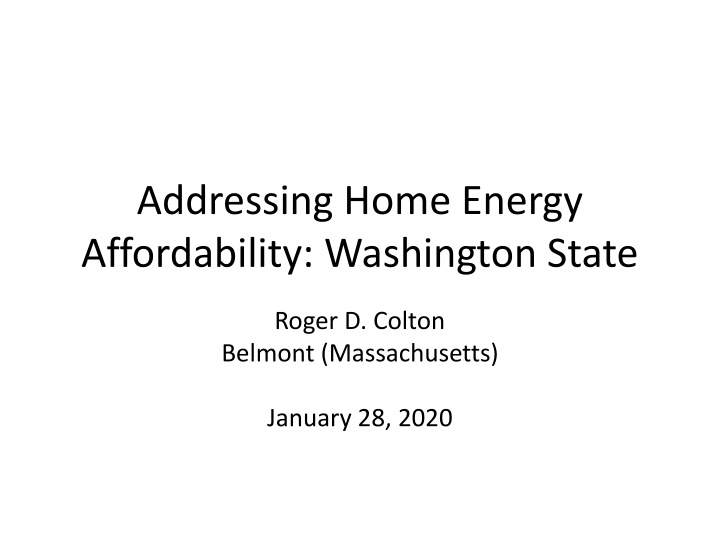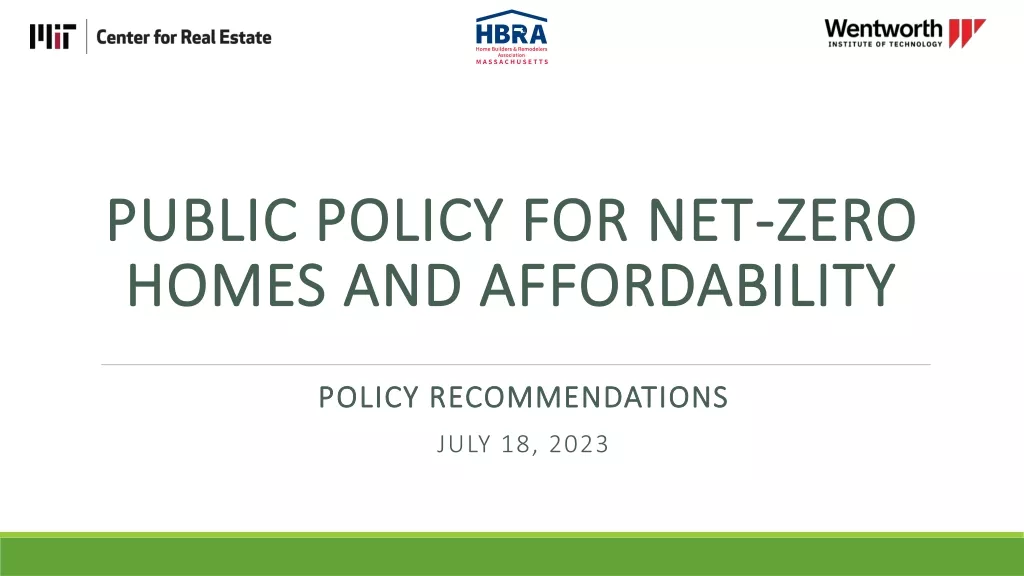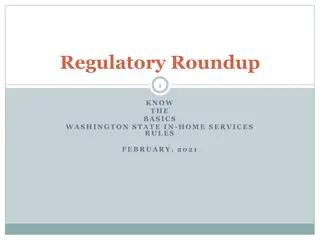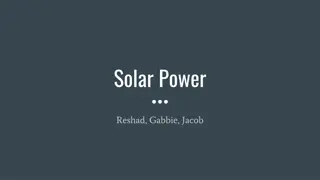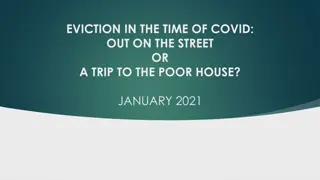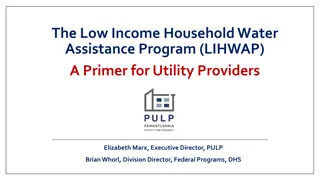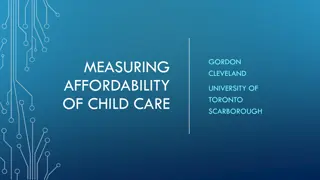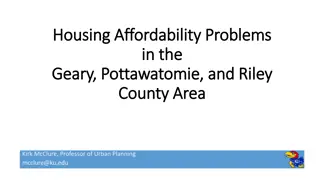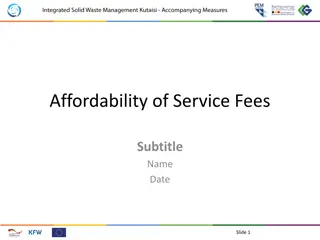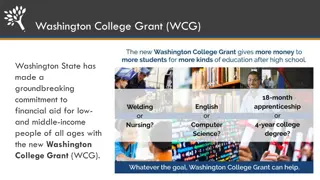Addressing Home Energy Affordability in Washington State
In this article, explore the importance of defining affordability objectives, considering single or multiple affordability burdens, and the effectiveness of income eligibility criteria in addressing home energy affordability. Learn how Pennsylvania and New York approach low-income energy objectives and the significance of setting an affordable energy burden in states like New Jersey.
Download Presentation

Please find below an Image/Link to download the presentation.
The content on the website is provided AS IS for your information and personal use only. It may not be sold, licensed, or shared on other websites without obtaining consent from the author.If you encounter any issues during the download, it is possible that the publisher has removed the file from their server.
You are allowed to download the files provided on this website for personal or commercial use, subject to the condition that they are used lawfully. All files are the property of their respective owners.
The content on the website is provided AS IS for your information and personal use only. It may not be sold, licensed, or shared on other websites without obtaining consent from the author.
E N D
Presentation Transcript
Addressing Home Energy Affordability: Washington State Roger D. Colton Belmont (Massachusetts) January 28, 2020
Three major topics today An important overview: defining your objective. Setting a single affordability burden (or allowing multiple burdens). Subsumed: statewide program or utility-specific programs. The inherent limits, and remaining usefulness, of increasing income eligibility.
Overview: Articulate the Objective In noting that affordability is the objective, remember that pursuing affordability, and thus offering a low-income discount, is a means to an end, not an end unto itself. The outcome which stakeholders should seek to achieve through a universal service program is the ability of income-challenged customers to take utility service under sustainable conditions. A reduced bill offered to low-income customers is not simply a distribution of financial benefits to the poor because they are poor. Instead, a properly designed discounted rate should be a mechanism through which utilities, in effect, seek to purchase an increase in the ability of low-income customers to consume their utility service while making consistent, timely payments for that service with a minimum of collection intervention.
Pennsylvania low-income objective: Pennsylvania PUC Staff Report (January 2019): The Competition Acts define universal service and energy conservation as the policies, practices, and services that help low-income customers maintain utility service. . .[T]he universal service provisions of the Competition Acts tie the affordability of electric and natural gas service to a customer s ability to maintain utility service. . .
An alternative: New Yorks affordability New York sets an affordable home energy burden at six percent of income. (Staff Report, at 84). The New York Commission firmly rooted its decision in social considerations: There is no universal measure of energy affordability; however, a widely accepted principle is that total shelter costs should not exceed 30% of income. For example, this percentage is often used by lenders to determine affordability of mortgage payments. It is further reasonable to expect that utility costs should not exceed 20% of shelter costs, leading to the conclusion that an affordable energy burden should be at or below 6% of household income. New York PSC Order Adopting Low Income Program Modifications and Directing Utility Filings at 3, Case 14-M-0565 (effective May 20, 2016).
Setting an affordable burden #1: New Jersey s 6% (50%/50% split) Distribution of Effective Coverage Rate by Net Energy Burden (New Jersey) (gas or electric: 3%) Coverage Rate Burden < 50% 50% - <90% 90% - <100% 100% or more <2% 0.0% 2.7% 5.3% 92.0% 2% - 3% 0.0% 6.0% 11.5% 82.5% 3% - 4% 0.0% 10.0% 13.2% 76.9% 4% - 6% 0.0% 11.6% 16.6% 71.6% 6% - 8% 0.4% 16.6% 17.4% 65.6% More than 8% 1.0% 25.6% 16.1% 57.4%
Setting an affordable burden #2: New Jersey s 6% (50%/50% split) Distribution of Effective Coverage Rate by Net Energy Burden (New Jersey) (combination gas/electric: 6%) Coverage Rate Burden < 50% 50% - <90% 90% - <100% 100% or more <4% 0.0% 9.0% 12.2% 78.8% 4% - 6% 0.7% 19.7% 17.2% 62.4% 6% - 8% 0.7% 18.9% 18.5% 58.8% 8% - 12% 1.8% 21.4% 21.7% 56.1% More than 12% 3.8% 31.1% 21.8% 43.2%
Over- and Under-Payment: Philly Water (City avg bill and income) / (21% flat discount) (4% affordability) Avg HH Income Avg HH Water Bill Bill at 4% of Income Dollar Discount Needed Dollar Discount Using City Over- (under-) payment Total Philly $13,066 $665 $523 $142 --- --- Far Northeast $15,089 $712 $604 $108 $152 $44 Near NE-West $8,600 $817 $344 $473 $174 ($299) North $5,980 $778 $239 $539 $166 ($373) East $10,342 $478 $414 $64 $102 $38 Northwest $16,840 $643 $674 ($31) $137 $168 Central $8,889 $837 $356 $481 $179 ($302) West $11,052 $658 $442 $216 $141 ($75) Center City $17,465 $655 $699 ($44) $140 $184 Southwest $17,015 $568 $681 ($113) $121 $234 Southeast $18,176 $737 $727 $10 $157 $147
Depth of Unaffordability: Status Quo and FCO by Tier and Heating/Non-heating Status Non-Heating Heating Percent Unaffordable Mean $s Above Affordable Percent Unaffordable Mean $s Above Affordable Tier Status Quo Status Quo Status Quo Status Quo FCO FCO FCO FCO B 85% 99% $383 $215 83% 98% $594 $384 C 52% 88% $483 $117 43% 75% $757 $184 D 36% 43% $472 $75 23% 21% $595 $107 D1 27% 27% $443 $64 17% 9% $660 $125 E 19% 5% $489 $76 11% 2% $722 $96 E1 16% 3% $492 $80 4% 1% $921 $193 Total 35% 39% $447 $124 25% 26% $652 $253 SOURCE: Appendix C, PECO Options Report, Docket No. M-2012-2290911. (FCO = Fixed Credit Option).
Total Dollars of Unaffordable Bills (PECO) Non-Heating Status Quo Alternative FCO Alternative Ratio: FCO to Status Quo Total Unaffordab le # of Pct Avg Total # of Pct Avg Total Income Tier Participa nts Unafford able Unafford able Bill Unaffordabl e Dollars Participa nts Unafford able Unafford able Bill Unaffordabl e Dollars B 9,809 85% $383 $3,193,320 9,809 99% $215 $2,087,846 65% C 17,462 52% $483 $4,385,756 17,462 88% $117 $1,797,888 41% D 25,261 36% $472 $4,292,349 25,261 43% $75 $814,667 19% D1 33,313 27% $443 $3,984,568 33,313 27% $64 $575,649 14% E 23,056 19% $489 $2,142,133 23,056 5% $76 $87,613 4% E1 18,478 16% $492 $1,454,588 18,478 3% $80 $44,347 3% Total xxx 35% $447 xxx xxx 39% $124 xxx Sum $19,452,714 $5,408,009 28%
Pennsylvania PUC: New Maximum Energy Burden Thresholds (09-19-19) (Docket M-2019-3012599) Utility Service Type 0-50% FPIG 51-100% FPIG 101-150% FPIG Electric Non-Heat 2% 4% 4% Gas Heat 4% 6% 6% Electric Heat 6% 10% 10%
The limits of a single percentage (and the dangers of inter-state comparisons) New Jersey (Ohio): Net energy burden (i.e., after LIHEAP) Illinois: Monthly maximum ($150) Annual maximum ($1,800) Pennsylvania: New burdens are maximums (not absolutes) (affordability a range and not a point). Burden calculated BEFORE LIHEAP. Minimum charge Maximum annual CAP credit ceilings (varies by utility) Fixed Credit Option (PECO) Includes all fees (e.g., late payment charge, reconnect fee) Adjust bill as a percentage of income intra-year
Modifying a single affordability percentage Some people receive a benefit of $0. If not. . . Tiered percentage by Poverty Level Ohio, New Jersey, Illinois: single percentage Pennsylvania: tiered percentage by Poverty Fixed Credit Option PECO: Constant credit, not constant payment. Split between heating and non-heating: New Jersey: 6%: (3%/3% heating and non-heating) Illinois: 6% (4% / 2% heating and non-heating) Pennsylvania: Tiered ranges
The Inherent Limits of Increasing Income Eligibility Affordable Bills at Increasing Income-Eligibility Ranges Electric (non- heating) 3-person HH income $31,170 $36,375 $41,560 Maximum Burden 2% Electric (heating)All Electric 150% Poverty 175% Poverty 200% Poverty $31,170 $36,375 $41,560 $31,170 $36,375 $41,560 150% of Poverty 4% 6% Affordable Bill (maximum burden x HH income) 150% Poverty 175% Poverty 200% Poverty $623.40 $727.50 $831.20 $1,246.80 $1,455.00 $1,662.40 $1,870.20 $2,182.50 $2,493.60
The Role of Increased Income Eligibility Emergency assistance (role of income fragility not merely income level). Weatherization (question is of overcoming market barriers, not of unaffordable burdens). Arrearage management (tie to regular payment of Budget Bill). Extreme weather protections (not based on burdens affordable burdens are annual, not seasonal in any event).
The fundamental components of energy assistance. Income-based bills tied to affordable burden. Arrearage management. Crisis assistance. Weatherization (usage reduction).
Percentage of Income Burdens and the Factors that Affect where such Burdens are Established In Ratepayer-funded Bill Payment Assistance Programs Limit on total annual program costs? Heating payment burden Non-heating payment burden Tiered by income or not? Limit on annual benefits? Uniform program type? Bill reduced by LIHEAP? Limit on cost per ratepayer? State Program type Who pays? Benefits < $50 not paid. <75% FPL: 7.1% 75 150% FPL: 12.1% Roughly 0.5% of total jurisdictional revenues Individual within design constraints <75%: 6% 75 150% FPL: 11.1% Varied by utility Maine Yes Yes No All ratepayers Benefit cap of $1,800. Yes (single charge to support LI assistance and energy conservation) Implied by the cap on the charge used to generate the subsidy fund. 4 5% (achieved by applying tiered percentage of bill discounts on first 750 kWh of usage) Single statewide program New Hampshire Tiered discount No (electric- only program) Yes No All ratepayers Single statewide program Single statewide program 3%: electric and gas standing alone. 6%: all electric 6% or $10 (lesser): gas and electric standing alone. 10% or $10 (lesser): all electric $1,800 per year. New Jersey PIPP No Yes No No All ratepayers No (LIHEAP applied to arrearages) Ohio PIPP No Yes No No All ratepayers Implied by the cap on the charge used to generate the subsidy fund. Single statewide program 3%: electric and gas standing alone. 6%: all electric Illinois PIPP No Yes $1,800 Yes All ratepayers Xcel: 3% gas and electric standing alone; 6% all electric SourceGas: <75% FPL: 2%; 75 125% FPL: 2.5%; 125%+: 3% Annual budget presented to CPUC for approval Individual within state constraints Varied by utility Some utilities but not all Colorado Yes No Yes All ratepayers Reduce individual household burden to not more than percentage of income paid at state median income (calculated annually) Per household benefit tiered by income and by household size LIHEAP added to ratepayer funds to comprise benefit Implied by the cap on the charge used to generate the subsidy fund. Single statewide program All retail customers Nevada PIPP Yes Yes
Recommended Reading: Cromwell, Colton, Rubin & Herrick (January 2010) Best Practices in Customer Payment Assistance Programs Water Research Foundation (American Water Works Association)
